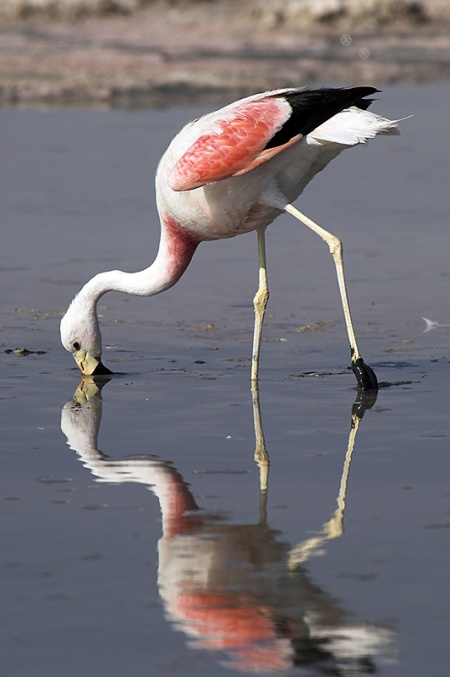- Phoenicoparrus andinus
Phoenicopterus andinus
Identification
102-110 cm.
- Pinkish-white body with darker pink patches particularly noticeable on base of neck and on folded wings
- Primaries, secondaries and tertials are all black
- seen as a black triangle at the rear of the standing bird
- Yellow legs and feet
- Yellowish bill with extensive black tip. Notice the shape with the cutting edge going very close to the top of the upper mandible.
Juveniles: grey, also on legs and inner half of bill
Similar species
Chilean Flamingo and James' Flamingo both have innermost flight feathers red (visible in flight). Juveniles and immatures are best separated by bill characteristics: cutting edge going down the middle in Chilean, the outer black part of the bill looking shorter, more attenuated in James'. If seen side by side, James' is a much smaller bird. Chilean is also smaller, but its proportionally longer legs makes this hard to see on standing birds.
Distribution
South America: found in southern Peru, Bolivia, northern Chile and North-western Argentina.
Taxonomy
This is a monotypic species[1].
Habitat
Salt and alkaline lakes.
Behaviour
Breeding
Its nest is a mud mound and 1 chalky white egg is laid. Both parents incubate the egg for about 28 days, and care for young, which fledges about 70-80 days later.
Diet
The diet includes algae.
References
- Clements, JF. 2011. The Clements Checklist of Birds of the World. 6th ed., with updates to August 2011. Ithaca: Cornell Univ. Press. ISBN 978-0801445019. Spreadsheet available at http://www.birds.cornell.edu/clementschecklist/downloadable-clements-checklist
- Answers.com
- Wikipedia
Recommended Citation
- BirdForum Opus contributors. (2025) Andean Flamingo. In: BirdForum, the forum for wild birds and birding. Retrieved 13 May 2025 from https://www.birdforum.net/opus/Andean_Flamingo
External Links
GSearch checked for 2020 platform.





